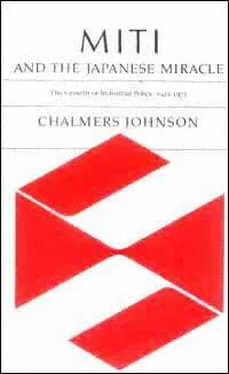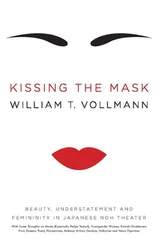Chalmers Johnson - MITI and the Japanese miracle
Здесь есть возможность читать онлайн «Chalmers Johnson - MITI and the Japanese miracle» весь текст электронной книги совершенно бесплатно (целиком полную версию без сокращений). В некоторых случаях можно слушать аудио, скачать через торрент в формате fb2 и присутствует краткое содержание. Год выпуска: 2007, Издательство: Stanford University Press, Жанр: Старинная литература, на английском языке. Описание произведения, (предисловие) а так же отзывы посетителей доступны на портале библиотеки ЛибКат.
- Название:MITI and the Japanese miracle
- Автор:
- Издательство:Stanford University Press
- Жанр:
- Год:2007
- ISBN:нет данных
- Рейтинг книги:3 / 5. Голосов: 1
-
Избранное:Добавить в избранное
- Отзывы:
-
Ваша оценка:
- 60
- 1
- 2
- 3
- 4
- 5
MITI and the Japanese miracle: краткое содержание, описание и аннотация
Предлагаем к чтению аннотацию, описание, краткое содержание или предисловие (зависит от того, что написал сам автор книги «MITI and the Japanese miracle»). Если вы не нашли необходимую информацию о книге — напишите в комментариях, мы постараемся отыскать её.
MITI and the Japanese miracle — читать онлайн бесплатно полную книгу (весь текст) целиком
Ниже представлен текст книги, разбитый по страницам. Система сохранения места последней прочитанной страницы, позволяет с удобством читать онлайн бесплатно книгу «MITI and the Japanese miracle», без необходимости каждый раз заново искать на чём Вы остановились. Поставьте закладку, и сможете в любой момент перейти на страницу, на которой закончили чтение.
Интервал:
Закладка:
2
The very thought of capital liberalization struck terror in the hearts of MITI officials and Japanese industrial leaders. In their view trade liberalization had meant only meeting world competition in terms of products (quality, design, price, and so forth), a level at which Japan had worked out the successful strategy of importing technology from Europe and America, combining it with Japanese labor power, and then offering to the market products that were able to compete profitably with those of other countries. But capital liberalization meant competition at every level of an enterprisein technology, capital resources, managerial skills, and all the rest. The low levels of capitalization of Japanese firms, a consequence of the indirect financing system invented during the capital shortage of the Korean War period, made them easy targets for foreign acquisition. The issue, of course, was nationalistic rather than economicthe belief on the part of some Japanese that the United States had for all intents and purposes "bought" Western Europeand was about to buy Japan, as well.
MITI had long feared that some such catastrophe might easily occur, and during the recession of 1965 (particularly after the bankruptcy of Sanyo* Special Steel), it began to deride what it called Japan's "cherry-blossom-viewing and sake-drinking economy," by which it meant numerous low equity, over-invested firms wholly dependent upon government-guaranteed bank loans.
3
If such firms could not even survive a domestic recession in a hothouse economy, how were they going to compete with the Fords, du Ponts, and IBMs of the world? The ministry argued that the solution to these problems was
Page 277
to promote large-scale mergers in order to produce concentrations of economic power on a par with the United States and West Germany. It wanted to reduce the "big six" steel companies to, say, two or three, and the automobile manufacturers from ten (Daihatsu, Fuji, Honda, Hino, Isuzu, Mitsubishi, Nissan, Suzuki, Toyo * Kogyo*, and Toyota) to two (Nissan and Toyota). The problem with this approach was that it was hard to merge Japanese firms, given their company unions, lifetime employment systems, and keiretsu affiliations. Moreover, such a policy would put MITI squarely on the side of big business, or even worse, of zaibatsu business. Some observers reinterpreted MITI's old slogan of "scrap and build" (first applied to the coal industry) to mean "scrap medium and smaller enterprises" and "build Mitsubishi Heavy Industries."
4
As it turned out, MITI had less to fear from medium and smaller enterprises than it did from some very big businesses themselves. And it had forgotten all about the Fair Trade Commission.
Before these problems developed, MITI got an assist from the top leaders of business, but for reasons more connected with the Sumitomo Metals Company incident than with capital liberalization itself. Inayama Yoshihiro, the president of Yawata Steel, had been so appalled by the "Sahashi, minister; Miki, vice-minister" controversy and the public squabbling over market shares in the steel industry that in January 1966 he proposed to Nagano Shigeo, president of Fuji Steel, that they merge their two companies. This would produce one steel company so large that it would create a genuine hierarchy in the industry, and, he hoped, conditions of stable oligopoly. Nagano responded favorably. In order to create a forum in which these negotiations could be pursued, in March 1966 the leaders of the main industrial federations formed a policy board, or "business general staff," named the Industrial Problems Research Association (Sangyo* Mondai Kenkyu* Kai, called "Sanken" for short). The big steel merger was Sanken's greatest achievement (it became inactive thereafter), but its formation coincided with the rise of the capital liberalization issue, and the association therefore decided to address the problem of mergers for all major industries as well as for steel.
5
In its fully elaborated form Sanken brought together leaders from steel, electric power, chemicals, machinery, textiles, trading, finance, and securities, plus representatives of medium and smaller enterprises. Its guiding intellectual orientation was provided by Nakayama Sohei (b. 1906), since 1961 the president of the Industrial Bank of Japan (Nihon Kogyo Ginko*) and probably the greatest go-between of modern Japanese business. He took charge of a committee to make recommendations for the reorganization of Japanese industry in order
Page 278
to end "excessive competition" and to prepare to meet the challenges of capital liberalization. The Nakayama Committee, augmented by bureaucrats from MITI and the EPA, worked on its report between July 1966 and June 1967. When it was completed, the report called for either mergers or "cooperation" in seven industries: steel, automobiles, machine tools, computers, petroleum refining, petrochemicals, and synthetic textiles. The committee's main contribution was to provide a rationale for the Yawata-Fuji merger, but its influence can be seen in many other areas, including both MITI's ultimately abortive efforts to reorganize the automobile industry and its very successful measures to link the electronics and machine tool industries.
6
While these analytic activities were underway, MITI was also busy preparing countermeasures to hold off liberalization until the basic phases of the reorganization could be accomplished. In January 1967 the ministry set up a Capital Transactions Liberalization Countermeasures Special Committee (Shihon Torihiki Jiyuka* Taisaku Tokubetsu Iinkai) within the Industrial Structure Council to hear and endorse what it proposed to do. This committee joined with another special committee set up by the Ministry of Finance's Foreign Capital Council (Gaishi Shingikai) and came up with a vast tangle of rules and procedures that had the effect of turning Japan's capital "liberalization" into a strictly pro forma acquiescence in international conventions.
Some of these rules included the 100 percent liberalization of only those industries in which foreign competition was unlikely (sake brewing, motorcycles, and the manufacture of
geta
, or Japanese wooden clogs, are the famous examples), the limitation of direct investment in other industries to joint ventures with at least 50 percent Japanese participation, the limitation of equity ownership in established firms to 20 percent, the selective designation of industries to be liberalized, the omission of vital segments from allegedly liberalized industries (the television industry was declared liberalized, except that foreigners could not produce color sets or use integrated circuits; the steel industry possessed eight of the ten largest blast furnaces on earth, but foreigners were prohibited from supplying the precise kind of steel needed by the automobile industry), the requirement that at least half of the directors in a joint venture must be Japanese nationals, and so forth endlessly. As if these measures were not enough, all proposed joint ventures or wholly owned subsidiaries remained subject to screening and approval by MITI under either the Foreign Exchange and Foreign Trade Control Law or the Foreign Capital Law if they involved the introduction of foreign technology into Japan.
7
(It is hard
Page 279
to imagine a joint venture or subsidiary that would not include the introduction of some form of technology or know-how).
On June 6, 1967, the cabinet adopted these principles and with great fanfare proclaimed the "first round" of capital liberalization on July 1. This opened up some 50 industries, 17 at 100 percent and 33 at 50 percent, to foreign participation. There can be no doubt that this initial effort was a purely cosmetic public relations gesture. All the industries liberalized were ones in which a Japanese enterprise controlled more than 50 percent of the market, or in which most of the products were sold exclusively to the Japanese government (railroad cars), or for which no Japanese market existed (corn flakes). Genuine capital liberalization came to Japan only slowly, and not through MITI's initiative but as a consequence of the weakening of the ministry and the growing realization on the part of industry that it had to "internationalize" if it was to avoid isolation. Ironically enough, by the time the economy was fully liberalized in the late 1970's, the big investors were not the Americans or the Europeans but the Arab oil sheiks.
Читать дальшеИнтервал:
Закладка:
Похожие книги на «MITI and the Japanese miracle»
Представляем Вашему вниманию похожие книги на «MITI and the Japanese miracle» списком для выбора. Мы отобрали схожую по названию и смыслу литературу в надежде предоставить читателям больше вариантов отыскать новые, интересные, ещё непрочитанные произведения.
Обсуждение, отзывы о книге «MITI and the Japanese miracle» и просто собственные мнения читателей. Оставьте ваши комментарии, напишите, что Вы думаете о произведении, его смысле или главных героях. Укажите что конкретно понравилось, а что нет, и почему Вы так считаете.












